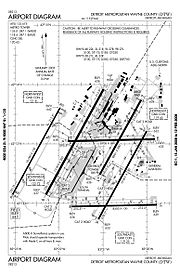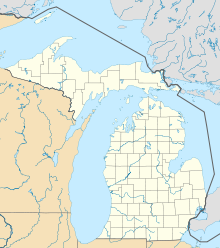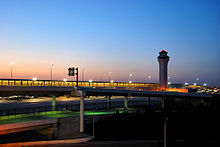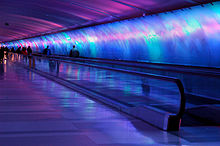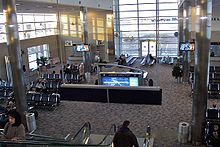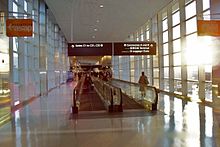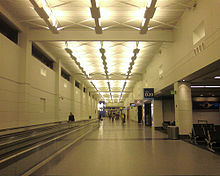- Detroit Metropolitan Wayne County Airport
-
"DTW" redirects here. For other uses, see DTW (disambiguation).
Detroit Metropolitan Wayne County Airport 
IATA: DTW – ICAO: KDTW – FAA LID: DTW Summary Airport type Public Owner Wayne County, Michigan Operator Wayne County Airport Authority Serves Detroit, Michigan Location Romulus, Michigan Hub for Elevation AMSL 645 ft / 197 m Coordinates 42°12′45″N 083°21′12″W / 42.2125°N 83.35333°WCoordinates: 42°12′45″N 083°21′12″W / 42.2125°N 83.35333°W Website Maps FAA airport diagram Location within Michigan Runways Direction Length Surface ft m 4R/22L 12,003 3,659 Concrete 4L/22R 10,000 3,048 Concrete 3R/21L 10,001 3,048 Concrete 3L/21R 8,501 2,591 Asphalt/Concrete 9L/27R 8,708 2,654 Asphalt/Concrete 9R/27L 8,500 2,591 Concrete Statistics (2010) Total passengers 32,377,064 International passengers 2,593,077 Aircraft operations 452,616 Source: www.MetroAirport.com[1] Detroit Metropolitan Wayne County Airport (IATA: DTW, ICAO: KDTW), usually called Detroit Metro Airport, Metro Airport locally, or simply DTW, is a major international airport covering 6,700-acre (10.5 sq mi; 2,700 ha)[2] in Romulus, Michigan, a suburb of Detroit. It is Michigan's busiest airport.
Metro Detroit's airport is the second-largest hub for Delta Air Lines. Delta, along with SkyTeam partner Air France, occupy the entire McNamara Terminal, which contains both domestic and international gates and serves as the airline's primary gateway to Asia and its third-busiest gateway to Europe. The airport is also a major gateway for tourism in metropolitan Detroit.[3] The airport is one of SkyTeam's major Midwestern hubs.[4] It is the second-largest base for Spirit Airlines,[5] where the airline was founded and once operated its largest base. Operated by the Wayne County Airport Authority, the airport is one of the nation's most-recently expanded and modernized airports, with six major runways, two terminals, 145 in-service gates,[6] and an on-site Westin Hotel and conference center. The McNamara Terminal Concourse A is the world's second-longest airport terminal building at 1 mi (1.6 km)[7] It is just surpassed by the 1.06 mi (1.71 km) long Kansai International Airport. The airport has maintenance facilities capable of servicing and repairing aircraft as large as the Boeing 747.[8]
In 2010, Detroit Metropolitan Wayne County Airport was the 16th-busiest airport in the United States and the 24th busiest airport in the world in terms of passenger traffic. In terms of aircraft operations (take-offs and landings), it remains one of the top 10 busiest airfields in North America.[9] Metro Airport also serves the Toledo, Ohio, area, which is located approximately 47 miles (76 km) south of the airport, and the city of Windsor, Ontario and Southwestern Ontario in nearby Canada.[10] The airport serves over 160 destinations[1] and was named the best large U.S. airport in customer satisfaction by J.D. Power & Associates in 2010.[11] In 2009, Detroit Metro Airport launched its first social media efforts with participation in Twitter, Facebook and YouTube networks.
Contents
History
Wayne County authorities began planning for a new airport in the western portions of the county as early as 1927. The following year, the county acquired one square mile of land for an aviation facility, to be called Wayne County Airport, at the corner of Middlebelt and Wick Roads, the northeastern boundary of today's airport. Construction was completed in 1929, and the first official landing took place on February 22, 1930. That same year, Thompson Aeronautical Corporation, a forerunner of American Airlines, inaugurated service from Wayne County. From 1931 until 1945, the airport housed Michigan National Guard operations gained by the Army Air Force. It was also named Romulus Army Airfield during the war. The original runway (14/32) was later decommissioned. However, parts of it remain today as Taxiways M-4 and P-4, transversing from southeast of Runway 3R/21L through Runway 9L/27R and ending northwest of Runway 3L/21R.[8]
Between 1947 and 1950, county officials expanded the small airport to become Detroit's primary airport. The airport was renamed Detroit-Wayne Major Airport in 1947 and over the next three years expanded in size threefold as three more runways were built. In 1949, runways 3L/21R and 9L/27R were built and in 1950 runway 4R/22L was added. During this time, most commercial traffic shifted from small Detroit City Airport (now Coleman Young International Airport) northeast of downtown Detroit to the larger Willow Run Airport over 20 mi (32 km) west of the city, and 10 mi (16 km) west of Wayne County Airport.[8]
During the 1950s Pan-Am and BOAC began operations at Detroit-Wayne Major. In the April 1957 Official Airline Guide they were the only passenger airlines: three Pan Am DC-7Cs a week FRA-LHR-SNN-DTW-ORD and back, and one BOAC DC-7C a week LHR-PIK-YUL-DTW-ORD and back (skipping YUL on the return flight).
1956 marked a major turning point in the history of the growing airport. American Airlines agreed to shift operations to Detroit-Wayne and did so in October 1958, accompanied soon after by four other carriers. Also, the Civil Aviation Administration (by now known as the Federal Aviation Agency) announced that year the inclusion of Detroit-Wayne in the first group of American airports to receive new long-range radar equipment, enabling the airport to become the first inland airport in the United States certified for jet aircraft operations. Also in 1958, the L.C. Smith (South) Terminal was completed to accommodate the new carriers, and the airport was given its present name.[8]
During the next decade the remaining passenger traffic at Willow Run gradually shifted to Metro Airport, and the North Terminal (later renamed the Davey Terminal) opened in 1966 to accommodate the new arrivals. Growing international traffic necessitated the building of a third terminal, the Michael Berry International Terminal, in 1974. The last of its original three parallel runways (3R/21L) was completed in 1976. A new parallel cross winds runway (9R/27L) opened in 1993.[8]
Republic Airlines began hub operations in 1984, and its merger with Northwest Airlines in 1986 expanded the hub greatly. Transpacific operations began in 1987 with non-stop flights to Tokyo. The last of Metro's six runways (4L/22R) was completed in December 2001 in preparation for the opening of the mile-long, 122-gate, $1.2 billion McNamara Terminal in the airport midfield in 2002.[8][12]
The present Runway 3L/21R has held four different identifier names. When opened in 1949, it was simply Runway 3/21. With the opening of the new west side Runway 3L/21R in 1950, the original 3/21 was renamed 3R/21L. With the opening of the new east side Runway 3R/21L in 1976, it was renamed 3C/21C. With the opening of Runway 4L/22R in December 2001 and the consequent splitting of the field into two sectors (3/21 on the east and 4/22 on the west) Runway 3C/21C was renamed Runway 3L/21R.
The Airport Authority has recently been said to be planning a project which would include an airport rail system, a new runway, and terminal expansions. The FAA projects that air traffic will grow 67% at Detroit Metro over the next 20 years, which would equate to 60 million passengers. The rail system would connect the existing McNamara Terminal and the new North Terminal together via tram with an anticipated consolidated rental car facility and a planned regional rail system. Also, the airport is considering extending Concourses B and C in the McNamara Terminal. To pay for these projects, the Airport Authority has asked Congress to raise the current $4.50 passenger facility fee to $7.00. Former hub carrier Northwest Airlines had opposed utilizing the passenger facility fee to fund the airport rail system (the airline later merged with Delta).[13]
The Wayne County Airport Authority's latest FAA Master Plan includes a number of proposed future developments to be considered at such time as demand warrants and funding is available. A significant element of this plan is a proposed new fifth parallel runway.[14] This addition would add to the airport's four existing parallel runways and its two cross-wind runways in order to alleviate future congestion.[15]
In April 2011, Lufthansa launched a unique curbside check-in and baggage check service for premium customers departing from DTW’s North Terminal to Frankfurt and beyond. In doing so, Lufthansa became the only airline allowing international customers departing from DTW to check their bags and receive a boarding pass directly at the curb, while DTW becomes Lufthansa’s first North American gateway to feature this service.[16][17]
Terminals
Edward H. McNamara Terminal
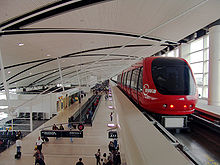 The McNamara Terminal's ExpressTram is used to transport passengers from one end of the terminal to the other
The McNamara Terminal's ExpressTram is used to transport passengers from one end of the terminal to the other
The McNamara Terminal, also known as the WorldGateway, opened on February 25, 2002. It was designed by SmithGroup. It was the replacement for the aged Davey Terminal, which was the principal hub for Northwest Airlines until its closing in 2002. During development, the terminal was known as the Midfield Terminal.[18] The terminal is used exclusively by Delta and its SkyTeam partners. It has three concourses, "A", "B", and "C", which house 121 gates with shopping and dining in the center of "A" concourse (known as "the link"), as well as throughout the concourses. In addition to moving walkways spaced along the length of each concourse, the "A" concourse has a people mover, the ExpressTram, that transports passengers between ends of the 1 mi (1.6 km) Concourse A in just over three minutes. Trams arrive almost simultaneously at the Terminal Station at the midpoint of the concourse and depart in opposite directions to the North Station and the South Station, then return.[19] The McNamara Terminal opened a new baggage sorting facility in October 2008, which has improved the screening of baggage through 14 different x-ray machines with bomb detection devices implemented on the conveyor system. Northwest Airlines said that it reduced the amount of lost baggage, and it improved the timeliness of bags getting to their correct flight.[20]
A Westin hotel is directly connected to the terminal. Additionally, overnight guests at the hotel who are not flying can obtain a pass to enter the concourses to visit shops and restaurants. Called the Airport Access Authorization to Commercial Establishments Beyond the Screen Checkpoint (AAACE), registered guests must undergo thorough background checks to pass through security. Dallas-Fort Worth International Airport is the only other airport participating in this program.[21]
The "A" concourse contains 64 gates with 12 gates being used for international departures and arrivals processing.[22] The "A" concourse is intended for all but the smaller regional aircraft and all international arrivals. There is a large, black granite water feature designed by WET in the center of the concourse. The concourse holds over 1.5 mi (2.4 km) of moving walkways. English and Japanese signage is found throughout the terminal because of regular flights to and from points in Japan, and signage in other languages is located in central areas.
The twelve international gates have dual jet bridges for a quicker deplaning time. They also contain two exit configurations depending on the arriving flight. Domestic arrivals follow the upper path directly into the terminal while international arrivals proceed downstairs to customs and immigration screening. The Customs and Border Protection processing center located in the terminal's lower level is designed to accommodate as many as 3,200 passengers per hour. International arriving passengers connecting to another flight are screened by TSA at a dedicated screening checkpoint within the international arrivals facility. Those passengers then exit directly back into the center of the "A" concourse.[23] Passengers arriving from international destinations who are ending their trip in Detroit (or connecting to a flight via North Terminal) exit directly into a dedicated International Arrivals Hall on the lower level of the terminal.
The "B" and "C" concourses currently have fifty-eight gates. The gates are used for Delta's smaller aircraft. Nearly all regional flights have jet bridges, eliminating the need for outdoor boarding.
The "B" and "C" concourses are connected to the main terminal building and the "A" Concourse by a pedestrian walkway under the tarmac. This walkway, known as the Light Tunnel, features an elaborate multi-colored light show behind sculpted glass panels extending the entire length of the walkway, as well several moving walkways. The light patterns are synchronized with an original musical score composed by Victor Alexeeff,[24] which runs for nearly a half hour before repeating. This installation, one of the first large scale uses of color changing LED lighting in the United States, was produced by Mills James Productions with glasswork by Foxfire Glass Works of Pontiac, Michigan. The display won multiple lighting design awards including the prestigious Guth Award of Merit. For passengers who are prone to medical conditions such as seizures, there are buttons at each end of the tunnel that will suspend the light show for five minutes so they can pass through with no adverse effects.
North Terminal
The North Terminal opened on September 17, 2008. It is the replacement for the aged Berry and Smith Terminals, which housed all non-SkyTeam airlines. Initially, Wayne County Airport Authority had put naming rights for the North Terminal up for to bid[25], but rights were never sold and the 'North Terminal' name stuck.
The terminal houses all non-SkyTeam airlines serving the airport. It is considered the "D" Concourse of the airport as the McNamara Terminal has Concourses A, B, and C. The concourse holds 26 gates, two of which opened in summer 2009 to accommodate international widebody flights to and from the terminal. The two gates could not be used at the time of the building's opening due to their extremely close proximity to Smith Terminal's C Concourse. The latter concourse was demolished after flights moved to the new terminal enabling the final two gates at the new terminal to be completed. The terminal features four long segments of moving walkways on the departures level and another on the lower level for international arriving passengers to access the Federal Inspection Services area.
The North Terminal houses two, six-lane security checkpoints. The terminal also has U.S Customs & Border Protection inspection facilities located on the lower level for arriving international flights.[26]
On January 29, 2010, the North Terminal was named winner of the "Build Michigan" award project.[27]
Airlines and destinations
Passenger airlines
Airlines Destinations Terminal Air Canada Express operated by Air Georgian Toronto-Pearson North Air Canada Express operated by Jazz Air Toronto-Pearson North Air France Paris-Charles de Gaulle McNamara AirTran Airways Atlanta, Orlando North American Airlines Dallas/Fort Worth, Miami North American Eagle Chicago-O'Hare, New York-LaGuardia North Continental Airlines Houston-Intercontinental North Continental Express operated by ExpressJet Airlines Houston-Intercontinental, Newark North Delta Air Lines Amsterdam, Atlanta, Austin, Baltimore, Beijing-Capital, Boston, Cancún, Charlotte, Chicago-O'Hare, Cincinnati/Northern Kentucky, Dallas/Fort Worth, Denver, Fort Lauderdale, Fort Myers, Frankfurt, Grand Rapids, Hong Kong, Indianapolis, Jacksonville, Kansas City, Las Vegas, London-Heathrow, Los Angeles, Madison, Manila, Memphis, Mexico City, Miami, Milwaukee, Minneapolis/St. Paul, Montego Bay, Nagoya-Centrair, Nashville, New Orleans, New York-JFK, New York-LaGuardia, Newark, Orlando, Philadelphia, Phoenix, Raleigh/Durham, Salt Lake City, San Antonio, San Diego, San Francisco, San José del Cabo, San Juan, São Paulo-Guarulhos, Seattle/Tacoma, Seoul-Incheon, Shanghai-Pudong, St. Louis, Tampa, Tokyo-Narita, Washington-National, West Palm Beach
Seasonal: Anchorage, Cozumel, Grand Cayman, Hartford/Springfield, Mazatlan, Nassau, Portland (OR), Puerto Vallarta, Punta Cana, Rome-Fiumicino, Sacramento, San Jose del Cabo, Sarasota/Bradenton, Tokyo-Haneda, Traverse City, VancouverMcNamara Delta Connection operated by Atlantic Southeast Airlines Birmingham (AL), Boston, Charlotte, Chicago-O'Hare, Cincinnati/Northern Kentucky, Columbus (OH), Dallas/Fort Worth, Evansville, Grand Rapids, Hartford, Houston-Intercontinental, Jacksonville (FL), Kansas City, Manchester (NH), Milwaukee, Nashville, Newark, Norfolk, Oklahoma City, Omaha, Philadelphia, San Antonio, Toronto-Pearson, Tulsa, Washington-National McNamara Delta Connection operated by Chautauqua Airlines Bangor, Buffalo, Burlington (VT), Columbus (OH), Dayton, Knoxville, Lexington, Louisville, Norfolk McNamara Delta Connection operated by Comair Appleton, Birmingham (AL), Boston, Buffalo, Charleston (SC), Chattanooga, Chicago-Midway, Cincinnati/Northern Kentucky, Cleveland, Fayetteville (AR), Flint, Fort Wayne, Grand Rapids, Greensboro, Harrisburg, Hartford, Huntington (WV), Huntsville/Decatur, Indianapolis, Kalamazoo, Knoxville, Lexington, Louisville, Madison, Milwaukee, Montréal-Trudeau, Nashville, Norfolk, Omaha, Philadelphia, Pittsburgh, Raleigh/Durham, Richmond, Saginaw, South Bend, Syracuse, Toronto-Pearson, Tri-Cities (TN/VA), Washington-Dulles
Seasonal: Lansing, Traverse CityMcNamara Delta Connection operated by Compass Airlines Chicago-O'Hare, Dallas/Fort Worth, Elmira, Green Bay, Indianapolis, Louisville, Manchester (NH), Milwaukee, Myrtle Beach, Nashville, New York-JFK, Oklahoma City, Pittsburgh, Raleigh/Durham
Seasonal: Grand RapidsMcNamara Delta Connection operated by Mesaba Airlines Alpena, Austin, Cedar Rapids, Chicago-O'Hare, Cincinnati/Northern Kentucky, Columbus (OH), Dallas/Fort Worth, Dayton, Des Moines, Escanaba, Flint, Grand Rapids, Hartford/Springfield, Houston-Intercontinental, Indianapolis, Iron Mountain, Madison, Marquette, Memphis, Nashville, New York-JFK, Newark, Philadelphia, Providence, Raleigh/Durham, Saginaw, San Antonio, Sault Ste. Marie, St. Louis, Toronto-Pearson, Traverse City, Wausau, White Plains
Seasonal: LansingMcNamara Delta Connection operated by Pinnacle Airlines Akron/Canton, Albany (NY), Allentown/Bethlehem, Alpena, Appleton, Asheville, Binghamton, Birmingham (AL), Bloomington/Normal, Buffalo, Burlington (VT), Cedar Rapids, Charleston (SC), Charleston (WV), Charlotte, Chicago-Midway, Cleveland, Columbia (SC), Columbus (OH), Dayton, Des Moines, Duluth, Elmira, Erie, Evansville, Fayetteville (AR), Flint, Fort Wayne, Grand Rapids, Green Bay, Greenville/Spartanburg, Hartford, Huntsville/Decatur, Indianapolis, Ithaca, Kalamazoo, Knoxville, La Crosse, Lansing, Lexington, Little Rock, Louisville, Madison, Manchester (NH), Milwaukee, Moline/Quad Cities, Monterrey, Montréal-Trudeau, Nashville, Newark, Newburgh, Norfolk, Omaha, Ottawa, Pellston, Peoria, Philadelphia, Pittsburgh, Portland (ME), Providence, Quebec City, Raleigh/Durham, Richmond, Roanoke, Rochester (NY), Saginaw, Sault Ste. Marie, Savannah, Scranton/Wilkes Barre, Sioux Falls, South Bend, State College (PA), Syracuse, Toronto-Pearson, Traverse City, Washington-Dulles, White Plains
Seasonal: Springfield (MO)McNamara Delta Connection operated by Shuttle America Chicago-Midway, Chicago-O'Hare, Columbus (OH), Hartford/Springfield, Indianapolis, Kansas City, Oklahoma City, St. Louis
Seasonal: Grand RapidsMcNamara Frontier Airlines Denver North Frontier Airlines operated by Republic Airlines Denver North Lufthansa Frankfurt North Royal Jordanian Amman-Queen Alia North Southwest Airlines Baltimore, Chicago-Midway, Denver, Nashville, Orlando, Phoenix, St. Louis North Spirit Airlines Atlantic City, Cancún, Chicago-O'Hare, Fort Lauderdale, Fort Myers, Las Vegas, Los Angeles, Myrtle Beach, New York-LaGuardia, Orlando, Tampa
Seasonal: West Palm BeachNorth United Airlines Chicago-O'Hare North United Express operated by Atlantic Southeast Airlines Chicago-O'Hare, Washington-Dulles North United Express operated by ExpressJet Airlines Chicago-O'Hare, Washington-Dulles North United Express operated by GoJet Airlines Chicago-O'Hare, Denver, Washington-Dulles North United Express operated by Mesa Airlines Chicago-O'Hare North United Express operated by SkyWest Airlines Chicago-O'Hare, Denver, Houston-Intercontinental North United Express operated by Shuttle America Chicago-O'Hare, Denver, Newark, Washington-Dulles North United Express operated by Trans States Airlines Chicago-O'Hare, Washington-Dulles North US Airways Charlotte, Philadelphia, Phoenix North US Airways Express operated by Air Wisconsin Philadelphia, Washington-National North US Airways Express operated by Mesa Airlines Charlotte North US Airways Express operated by Republic Airlines Charlotte, Philadelphia North Top destinations
Busiest Domestic Routes from DTW (June 2010 - May 2011)[28] Rank City Passengers Carriers 1  Atlanta, GA
Atlanta, GA659,000 AirTran, Delta 2  Orlando, FL
Orlando, FL540,000 AirTran, Delta, Southwest, Spirit 3  New York, NY (LGA)
New York, NY (LGA)440,000 American, Delta, Spirit 4  Las Vegas, NV
Las Vegas, NV439,000 Delta, Spirit 5  Chicago, IL (ORD)
Chicago, IL (ORD)428,000 American, Delta, United 6  Denver, CO
Denver, CO413,000 Delta, Frontier, Southwest, United 7  Minneapolis/St. Paul, MN
Minneapolis/St. Paul, MN406,000 Delta 8  Phoenix, AZ
Phoenix, AZ404,000 Delta, Southwest, US Airways 9  Fort Lauderdale, FL
Fort Lauderdale, FL369,000 Delta, Spirit 10  Los Angeles, CA
Los Angeles, CA368,000 Delta, Spirit Cargo airlines
Airlines Destinations ABX Air Wilmington, Rochester DHL New York-JFK FedEx Express Newark, Indianapolis, Memphis FedEx Feeder operated by CSA Air Findlay UPS Airlines Louisville, Philadelphia, Chicago/Rockford Historical terminals
Michael Berry Terminal
The Berry Terminal, named for a former airport commissioner, was designed by Detroit architect Louis G. Redstone, and opened in 1974 as the international terminal at DTW. It was decommissioned on September 17, 2008 and replaced by the North Terminal; however, the airport authority voted on May 20, 2009, to renovate the terminal to house its offices.[29] All international passengers would arrive at this terminal, go through customs and immigration inspection, and continue on to their connecting flights by bus to adjacent terminals.
Originally containing six gates (two of which were removed in 2003 to allow for construction of an adjacent Northwest Airlines maintenance hangar), the terminal was later used for scheduled and charter flights. There were still several international scheduled flights on low cost carriers to destinations in the Caribbean and other warm-weathered places in the early 2000s, including flights from Champion Air, Ryan International Airlines and USA3000 Airlines. There were also four charter airlines that used this terminal.
Since its closure in 2008, the Berry Terminal has become a popular space for commercial film and television production. Films such as Up in the Air (2009), Machine Gun Preacher (2011) and This Must Be the Place have used the now-vacant terminal as a set (in addition to shooting in and around the airport's active terminals).
L. C. Smith Terminal
The Smith Terminal, named for Detroit-Wayne Major airport visionary Leroy C. Smith, was built in 1957. Though cited as the oldest of Metro Airport's terminals, that designation belongs to the Executive Terminal building located near Middlebelt Road and Lucas Drive, 1/4 mile east. The Executive Terminal was built in the late 1920s and is still in operation today as home to Signature, a flight support company.
The Smith Terminal's thirty-two gates originally housed Northwest Orient Airlines, Allegheny Airlines (forerunner to US Airways), Eastern Airlines, and Pan-Am, among others. A control tower was included in the construction, and served its purpose until the late 1980s, when a new control tower was built near the site of the new McNamara Terminal.
In later years, Smith Terminal hosted North American airlines other than Northwest, Continental, and later Delta, which was relocated to the McNamara Terminal after its 2002 completion.
State of the art for its time, the Smith Terminal eventually became victim to airline expansion. The design of the building did not allow for physical expansion of the ticketing area. To accommodate additional airlines, ticketing counters were constructed on the sides of the lobby in areas that previously held lounges and retail.[30] In contrast, the North Terminal was constructed with future expansion in mind.
Spirit Airlines, which operated out of many of the gates once used by Northwest, had done few upgrades to the gate areas in those parts of the terminal. The Northwest Airlines display boards near check-in counters at each gate remained in place, with the Northwest logos removed, and a Spirit information board simply affixed over the old display board.
On September 10, 2008, the Detroit News reported that Smith Terminal itself will not be demolished due to the airport authority offices remaining on the upper floors and mezzanine. However, the Detroit Free Press of October 9, 2008 stated that maintaining the terminal in its present condition would cost upwards of $4 million annually in utilities, a sore spot for airlines at DTW who foot the bill, in part, through airport landing fees; the airlines were hoping for a greater cost savings once the Smith and Berry Terminals were decommissioned.[31] On May 20, 2009, the airport authority formally voted to totally vacate the Smith Terminal, while retaining and renovating the Berry Terminal for its offices.[29]
Discussions were also raised regarding proposed construction of a new building to house the Airport Authority offices and Airport Police, with a preliminary price tag of $31.5 million.
James M. Davey Terminal
The Davey Terminal was built in 1966 and was first known as "Terminal 2" or the "North Terminal". It was designed by the firm of Smith, Hinchman and Grylls and was said to be the largest post tensioned building in the world. Tapering cruciform columns around the perimeter and curved beams supported five large concrete roof panels. The lack of columns allowed maximum flexibility in the interior space. The spaces between the roof panels and exterior columns were filled with glass to allow abundant natural light into the building.[32] It was renamed the "J. M. Davey Terminal" in 1975 in honor of former airport manager James M. Davey. It originally contained three concourses labeled C to E, as well as a Host Hotel which later was rebranded Marriott.[33] In the early 1980s, a separate ticketing area was constructed to the north of the Davey Terminal, along with Concourses F and G to eventually accommodate Northwest Airlines' regional jet fleet.
Over time, the terminal and added concourse began showing its age due to its layout and poor maintenance, hastened further by increased aircraft traffic, which it was not designed to handle efficiently. Despite this, more gates were added to Concourse C in a short-term expansion project in the early 1990s, making it 26 gates in length. This concourse was considered the worst by most travelers due to its long distance from the center of the terminal, and for its length.
The Davey Terminal was originally the principal base of operations for Republic Airlines, which merged with Northwest Orient Airlines into Northwest Airlines by 1986. Upon relocation of Northwest operations to the McNamara Terminal, the Davey Terminal was mothballed for three years before demolition of the ticketing area and Concourse G began on October 17, 2005 in preparation for the North Terminal project. All concourses of the Davey Terminal and adjoining Marriott hotel, except gates 1 to 11 of Concourse C, were subsequently demolished in 2005–06 (the remaining gates were in use by Spirit Airlines until the new North Terminal opened on September 17, 2008).[34]
Parking and ground transportation
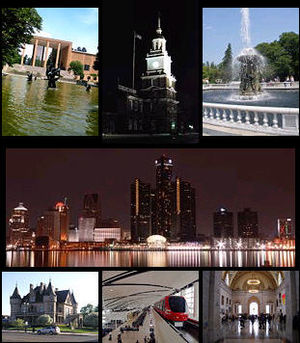 The airport serves as a gateway to Metro Detroit.
The airport serves as a gateway to Metro Detroit.
The McNamara Terminal Parking Structure is an 89 acres (36 ha) 10-level facility, which opened in February 2002. It is one of the largest parking structures in the world. It includes a ground transportation center, pedestrian bridge, two luggage check-in locations, conveyors and bridges to transport luggage, six restrooms, three offices for parking officials, and two electrical substations. The structure can park 11,489 cars in seven user groups. Parking for the North Terminal is offered in a garage known as the Big Blue Deck.[35] Two additional outdoor lots, named "yellow" and "red," serve as overflow parking. The October 9, 2008 edition of the Detroit Free Press noted that one of the two latter lots (not identified specifically) could be closed in the near future due to airport budget constraints. Four additional, privately owned parking lots are located outside airport grounds (Airlines Parking, Park 'N' Go, Qwik Park, U.S. Park). Motorcycle parking is free at the airport. Motorcycles can be parked in a separate covered area from cars at the McNamara Terminal Parking Structure.
The airport is accessible from I-94, which is the closest entrance to the North Terminal, and from I-275 via Eureka Road, which is closer to the McNamara Terminal. John D. Dingell Drive (named after John D. Dingell) is an expressway that runs from I-94 to Eureka Road. This expressway was built in 1999 for access to the McNamara Terminal. Many other local roads (including Goddard Road, Northline Road, Ecorse Road, Middlebelt Road, Merriman Road, and Wick Road) all have access to the airport and its surrounding property.[36]
Most major rental car companies serve the airport. Taxis are provided by MetroCab, while limousine service and luxury vehicle service is provided by MetroCars.[37]
The Suburban Mobility Authority for Regional Transportation (SMART)[38] provides bus routes 125 (Fort Street – Detroit) and 280 (Middlebelt Road), one per hour, that connect the airport with the rest of Metro Detroit. Terminal To Terminal shuttles provide free transport between the McNamara and North Terminals. Robert Q. Airbus also provides independent shuttle services to destinations in Southern Ontario, and most hotels located within the airport perimeter provide their own shuttle services as well.
The McNamara and North Terminals also have cell phone lots. The McNamara Terminal cell phone lot is located on the south side of Eureka Road between I-275 and the airport entrance ramp. The North Terminal cell phone lot is located near I-94 at the Middlebelt Road exit and near the on-airport car rental facilities. Both cell phone lots are clearly marked and unattended vehicles are prohibited.[39]
Metro Airport has also introduced a new system (1>2>3 PARK) which enables travelers to pay by swiping their credit or debit card. This new system is simple because it does not need a parking stub to know the duration of the travelers' stay. As of now, the "Big Blue Deck", the surface parking lots, and the McNamara Terminal parking structure currently have and use this new system.[40]
There is a Ground Transportation Center which is directly across from the North Terminal near the current "Big Blue Deck" parking structure, which has been expanded to include a further 800 parking spaces.
The Michigan Flyer provides bus service between the airport and Ann Arbor, Jackson, and East Lansing eight times daily.
Out of town shuttle service is available for passengers wishing to connect to flights at Toronto Pearson International Airport in Toronto.
The planned SEMCOG Commuter Rail system, with terminals at Ann Arbor and Detroit, would stop at the airport and provide rail transportation to and from the city.[41]
Awards
- J.D. Power and Associates ranked Metro Airport #1 in overall customer satisfaction nationwide among large airports in 2009 and 2010, up from #2 in 2008.[42][43]
- Airports Council International (ACI) ranked Metro Airport the #3 best airport in North America along with the Ottawa, Canada airport in 2006. ACI also named Metro Airport the #3 best airport with 25–40 million passengers in 2006.[44]
- Airports Council International (ACI) ranked Metro Airport the #5 best airport in North America in 2007. ACI also named Metro Airport the #3 best airport with 25–40 million passengers in 2007.[45]
Various airport names
Besides its official name, Detroit Metropolitan Wayne County Airport, the airport is known as
- Detroit Metropolitan Airport
- Detroit Metro Airport
- Metro Airport (locally)
- DTW, which stands for Detroit/Wayne, as the airport is within Wayne County.
- Metro (locally)
Accidents and incidents
- June 12, 1972, After a stopover in Detroit American Airlines Flight 96 a McDonnell Douglas DC-10-10 with 56 passengers and 11 crew from Los Angeles International Airport en route to Buffalo, New York suffered a cargo door failure and explosive decompression shortly after departure form Detroit Metropolitan Airport while flying over Windsor, Ontario. It is thus sometimes referred to as the Windsor incident.[46]. The Jumbo Jet sustained damage which left the pilots without full flight controls but the plane returned to Detroit for a successful emergency landing. There were no fatalities but several serious to minor injuries.
- July 31, 1972, Delta Airlines Flight 841; Members of the Black Liberation Army took over the airplane in flight using weapons smuggled on board, including a bible cut out to hold a handgun. The plane held 7 crew and 94 passengers, none of whom was killed during the hijacking. Five hijackers who had boarded with three children took over the plane. The plane flew to Miami where the passengers were exchanged for $1 million in ransom. The plane was then flown on to Boston where it refueled before flying to Algeria. Algeria seized the plane and ransom which they returned to the U.S. but the hijackers were released after a few days.
- March 4, 1987, Northwest Airlink Flight 2268, operating under Fischer Brothers Aviation, a CASA 212 was on a scheduled flight from Mansfield to Detroit with an intermediate stop in Cleveland when it crashed while landing at Detroit Metropolitan Wayne County Airport. The plane yawed violently to the left about 70 feet (21 m) above the runway, skidded to the right, hit 3 ground support vehicles in front of Concourse F and caught fire. Out of 19 occupants onboard (16 passengers and 3 crew)), 9 were killed. The cause of the crash was determined to be pilot error. [47]
- On August 16, 1987, a McDonnell Douglas MD-82 operating as Northwest Airlines Flight 255,[48] bound for Phoenix, Arizona, and Santa Ana, California, crashed on take-off from Metro's 8,500-foot (2,600 m)-long Runway 3 Center (Now Runway 3L). All but one passenger on the aircraft were killed; the lone survivor was a young girl, Cecelia Cichan, who lost both of her parents and her brother. The NTSB determined that the accident resulted from flight crew's failure to deploy the aircraft's flaps prior to take-off, resulting in a lack of necessary lift. The aircraft slammed into an overpass bridge on Interstate 94 just northeast of the departure end of the runway.[49]
- On December 3, 1990, a McDonnell Douglas DC-9-14 operating as Northwest Airlines Flight 1482, bound for Pittsburgh,[50] collided with a Boeing 727–200 Adv. operating as Northwest Airlines Flight 299.[51] bound for Memphis, on runway 03C. Seven passengers and a flight attendant on flight 1482 were killed. The cause of the accident is listed as "pilot error."[52][53]
- On January 9, 1997, an Embraer EMB 120 Brasilia aircraft operating as Comair Flight 3272 crashed nose down 18 miles (29 km) from the airport while on approach into Detroit. All 26 passengers and 3 crew members were killed. The cause is listed to be the "FAA's failure to establish adequate aircraft certification standards for flight in icing conditions, the FAA's failure to ensure that an FAA/CTA-approved procedure for the accident airplane's deice system operation was implemented by U.S.-based air carriers, and the FAA's failure to require the establishment of adequate minimum airspeeds for icing conditions."[54]
- On December 25, 2009, a Nigerian national Umar Farouk Abdulmutallab allegedly attempted to detonate an explosive device on Northwest Airlines Flight 253, an Airbus A330 from Amsterdam to Detroit as the plane was approaching Detroit. The device failed to go off correctly, and the suspect suffered burns to his lower body. Three other passengers had minor injuries. The White House said it considered the incident an attempted terrorist attack.[55]
See also
- Bishop International Airport
- Coleman A. Young International Airport
- Detroit Region Aerotropolis
- Michigan World War II Army Airfields
- Selfridge Air National Guard Base
- Willow Run Airport
References
 This article incorporates public domain material from websites or documents of the Air Force Historical Research Agency.
This article incorporates public domain material from websites or documents of the Air Force Historical Research Agency.- ^ a b [1]
- ^ Detroit Region Aerotropolis Website
- ^ Metroairport.com
- ^ Metroairport.com
- ^ Spirit Airlines – cheap tickets, cheap flights, discount airfare, cheap hotels, cheap car rentals, cheap travel
- ^ DTW Facts (Wayne County Airport Authority)
- ^ Metro Airport's McNamara Terminal Concourse A Is Second-Longest Terminal Building In The World
- ^ a b c d e f Howtoadvice.com
- ^ Airports Council International 2010 Final Airport Traffic Report
- ^ Directions to Metro Airport from Windsor, Ontario, Canada
- ^ Helms, Matt. Metro Airport tops in customer survey, Detroit Free Press, freep.com, February 18, 2010
- ^ Metro Airport History
- ^ Metro Airport Plans To Expand and Add An Airport Rail System (USA Today: November 12, 2007)
- ^ Metroairport.com
- ^ Detroit Metro Airport Proposes A 7th Runway (USA Today: February 22, 2008)
- ^ http://www.metroairport.com/uploads/docs/NR_LH_Curbside_Launch.pdf
- ^ http://www.lufthansa.com/online/portal/mam/us/program/news/detail?nodeid=3289492&l=en&cid=1000390
- ^ Metroairport.com
- ^ McNamara Terminal Map
- ^ Online Version Unavailable (Detroit Free Press)
- ^ DHS.gov
- ^ McNamara Terminal Map
- ^ Metroairport.com
- ^ The McNamara Tunnel, JimOnLight.com, Nov 2008, http://www.jimonlight.com/2008/11/18/the-mcnamara-tunnel-detroit-airport/
- ^ Shea, Bill (2008-03-24). "Name of Metro Airport’s north terminal for sale". Crain's Detroit Business. http://www.crainsdetroit.com/apps/pbcs.dll/article?AID=/20080324/SUB/100547109.
- ^ Metroairport.com
- ^ Yahoo Finance.com
- ^ Transtats.bts.gov
- ^ a b Mary Frances Masson. "Old terminal at Metro Airport to be vacated". Detroit Free Press. http://www.freep.com/article/20090520/BUSINESS06/905200305/1002/rss02. Retrieved May 27, 2009.[dead link]
- ^ Metro Airport's Smith Terminal Restaurants, Shops, and Services
- ^ Freep.com
- ^ Meyer, Katherine Mattingly and Martin C.P. McElroy with Introduction by W. Hawkins Ferry, Hon A.I.A. (1980). Detroit Architecture A.I.A. Guide Revised Edition. Wayne State University Press. ISBN 0-8143-1651-4.
- ^ Metro Airport History
- ^ Metro Airport History: 2000's
- ^ Metro Airport Parking Information
- ^ Metro Airport Driving Accessibility
- ^ Metro Airport Ground Transportation Information
- ^ Smart Bus Routes in Metro Detroit
- ^ Metro Airport Cell Phone Lane Information
- ^ Metro Airport Unveils New Parking System, 1>2>3 PARK
- ^ "Ann Arbor to Detroit rail could be running by year-end, officials say". AnnArbor.com. 31 January 2010. http://www.annarbor.com/news/ann-arbor-to-detroit-rail-could-be-running-by-year-end-officials-say/. Retrieved 29 January 2011.
- ^ Detroit Metro Airport Ranked #1 Overall in Customer Satisfaction by J.D. Power
- ^ [2]
- ^ Detroit Metro Airport Ranked #3 Best Airport by ACI
- ^ Detroit Metro Airport Ranked #5 Best Airport by ACI
- ^ Nicholas Faith (1996, 1998). Black Box: pp.157-158
- ^ NTSB report
- ^ Northwest Airlines Flight 255 Accident Description
- ^ Flight255memorial.com
- ^ Northwest Airlines Flight 1482 Accident Description
- ^ Northwest Airlines Fight 299 Accident Description
- ^ Aviation-safety.net
- ^ Aviation-safety.net
- ^ Comair Flight 3272 Accident Description
- ^ Officials: Possible terror attack on Northwest jet, MSNBC.
External links
- Official website
- Wayne County-Detroit Metro Airport History
- Detroit Spotters
- FAA Airport Diagram (PDF), effective 20 October 2011
- FAA Terminal Procedures for DTW, effective 20 October 2011
- Preferred Development Plan
- Resources for this airport:
- AirNav airport information for KDTW
- ASN accident history for DTW
- FlightAware airport information and live flight tracker
- NOAA/NWS latest weather observations
- SkyVector aeronautical chart for KDTW
- FAA current DTW delay information
Metro Detroit Topics Architecture · Culture · Detroit River · Economy · Freeways · History · Historic places · International Riverfront · Lake St. Clair · Media · Music · Parks and beaches · People · Skyscrapers · Sports · Theatre · Tourism · Transportation
Major city Municipalities
over 80,000Canton Township · Clinton Township · Dearborn · Livonia · Sterling Heights · Troy · Warren · WestlandMunicipalities
45,000 to 80,000Dearborn Heights · Farmington Hills · Grosse Pointe · Macomb Township · Novi · Pontiac · Redford Township · Rochester Hills · Royal Oak · St. Clair Shores · Shelby Township · Southfield · Taylor · Waterford Township · West Bloomfield TownshipSatellite cities Counties in MSA Counties in CSA Regions Outlying regions  Michigan ·
Michigan ·  United States
United StatesMajor airports of the United States Atlanta (Hartsfield–Jackson Atlanta International Airport – ATL) · Baltimore (Baltimore/Washington International Thurgood Marshall Airport – BWI) · Boston (Logan International Airport – BOS) · Charlotte (Charlotte/Douglas International Airport – CLT) · Chicago (O'Hare International Airport – ORD) · Dallas-Fort Worth (Dallas/Fort Worth International Airport – DFW) · Denver (Denver International Airport – DEN) · Detroit (Detroit Metropolitan Wayne County Airport – DTW) · Fort Lauderdale (Fort Lauderdale – Hollywood International Airport – FLL) · Honolulu (Honolulu International Airport – HNL) · Houston (George Bush Intercontinental Airport – IAH) · Las Vegas (McCarran International Airport – LAS) · Los Angeles (Los Angeles International Airport – LAX) · Miami (Miami International Airport – MIA) · Minneapolis – Saint Paul (Minneapolis-Saint Paul International Airport – MSP) · Newark (Newark Liberty International Airport – EWR) · New York (John F. Kennedy International Airport – JFK) · New York (LaGuardia Airport – LGA) · Orlando (Orlando International Airport – MCO) · Philadelphia (Philadelphia International Airport – PHL) · Phoenix (Phoenix Sky Harbor International Airport – PHX) · Salt Lake City (Salt Lake City International Airport – SLC) · San Diego (San Diego International Airport – SAN) · San Francisco (San Francisco International Airport – SFO) · Seattle (Seattle–Tacoma International Airport – SEA) · Tampa (Tampa International Airport – TPA) · Washington, D.C. (Ronald Reagan Washington National Airport – DCA) · Washington, D.C. (Washington Dulles International Airport – IAD)
Categories:- 1930 establishments in the United States
- Airports established in 1930
- Economy of Metro Detroit
- Airports in Wayne County, Michigan
- Economy of Detroit, Michigan
- Airfields of the United States Army Air Forces in Michigan
- USAAF Air Transport Command Airfields - North America
Wikimedia Foundation. 2010.

